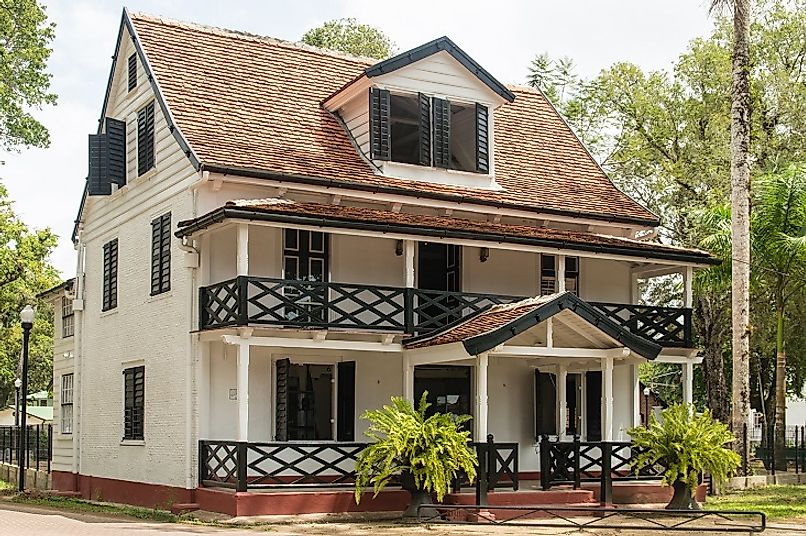American Flags Express | Machined Pole Parts | CDN - american flags express



"God zij met ons Suriname" ("God be with our Suriname") is the national anthem of Suriname. The music of the anthem have been composed by Johannes Corstianus de Puy. The Dutch lyrics of the anthem have been penned by Cornelis Atses Hoekstra; while the SrananTongo lyrics have been authored by Henri Frans de Ziel. The anthem was officially adopted on December 7, 1959.
The current official National Coat of Arms of Suriname was adopted on November 25, 1975. It features two natives carrying a shield with two halves. The left half of the shield represents the past: as slaves were abducted via ship out of Africa. The right half, the side of the present: shows a Royal Palm, the symbol of a just person ("The just person should blossom like a palm"). The diamond in the middle is the stylized form of the heart, which is regarded as the organ of love. The points of the diamond show the four directions of the wind. Inside the diamond is a five-pointed star. This star symbolizes the five continents from which the inhabitants of Suriname migrated: Africa, America, Australia, Asia, and Europe. The two natives and the shield are placed on a red banner displaying the National Motto: "Justitia - Pietas - Fides" ("Justice - Piety - Fidelity").
Until 1942, Suriname used Dutch coins and then coins made by the United States for use in various Dutch colonies. Beginning 1962, coins bearing the name Suriname were minted and circulated in the denominations of 1, 5, 10, and 25 cents, as well as 1 guilder. In 1987, the 250-cent coin was introduced. Despite the introduction of the Surinamese dollar in 2004, existing coins in denominations: 1, 5, 10, 25, 100, and 250 cents from the previous currencies remain in circulation.
The Central Bank of Suriname assumed the role of producing paper money in 1957 and issued banknotes in denominations of 5, 10, 25, 100, and 1,000 guilders. In 1982, the 500 guilder note was introduced, followed by a 250 guilder note in 1988, a 2,000 guilder note in 1995, a 5,000 guilder note in 1997, and a 25,000 guilder note in 2000. The last series of the guilder notes, which bear the portrait of native birds and flowers, was issued in 2000 in denominations of 5, 10, 25, 100, 500, 1,000, 5000, 10,000, and 25,000 guilders. After the introduction of the Surinamese dollar in 2004, new notes were issued in denominations of 5, 10, 20, 50, 100 dollars.
The Surinamese dollar was introduced in 2004 and replaced the Surinamese guilder. The Surinamese guilder was on par with the Dutch guilder, and after the occupation of the Netherlands in World War II, which began in 1940, both currencies were pegged to the United States dollar at a rate of 1 dollar = 1.88585 guilders. In the early 1990s, the glider experienced a high rate of inflation and on 1 January 2004, it was replaced by the Surinamese dollar at a rate of 1 dollar = 1000 guilders. As at the time of replacement, only coins were available due to a delay in printing the notes by the Canadian Bank Note Company. Guilder coins in denominations of 1, 5, 10, and 25 cents retained their value in the new cents. This meant that a 25-cent guilder coin would be worth 1⁄4 dollar, which represented 250 guilders. In 2011, the Suriname dollar (SRD) was pegged to the USD at a rate of 1 USD =0.3.25 SRD. In November 2015, the currency was devalued and pegged at 1 USD = 4.0 SRD, and in 2016 the peg was further moved to 1 USD = 7.46 SRD.
The National Flag of Suriname features five unequal horizontal bands of green (top, double-width), white, red (quadruple width), white, and green (double width). A large, yellow, five-pointed star is centered in the red band. The red color stands for progress and love. The green color symbolizes hope and fertility. The white color signifies peace, justice, and freedom. The star represents the unity of all ethnic groups. The yellow light of the star inspires the nation to draw strength to bear sacrifices patiently while working toward a golden future. The flag has a width-to-length proportion ratio of 2:3.
From the early 19th century, Suriname had been a Dutch colony. The official flag that represented Suriname during this time, was the flag of the Dutch Overseas Territory 1959. This flag featured a white field with five stars of different colors placed on an ellipse. Each of the colored stars symbolized the different ethnic races living in Suriname: the white for Europeans, black for Creoles, brown for Indians, red for American Indians, and yellow for the Chinese respectively. Suriname gained independence from the Dutch in 1975. The current flag of Suriname was selected as a result of a nationally sponsored competition at the time of independence in 1975.
The National Flag of Suriname was officially adopted on November 25, 1975. The flag has been designed by Jacques Herman Pinas.

